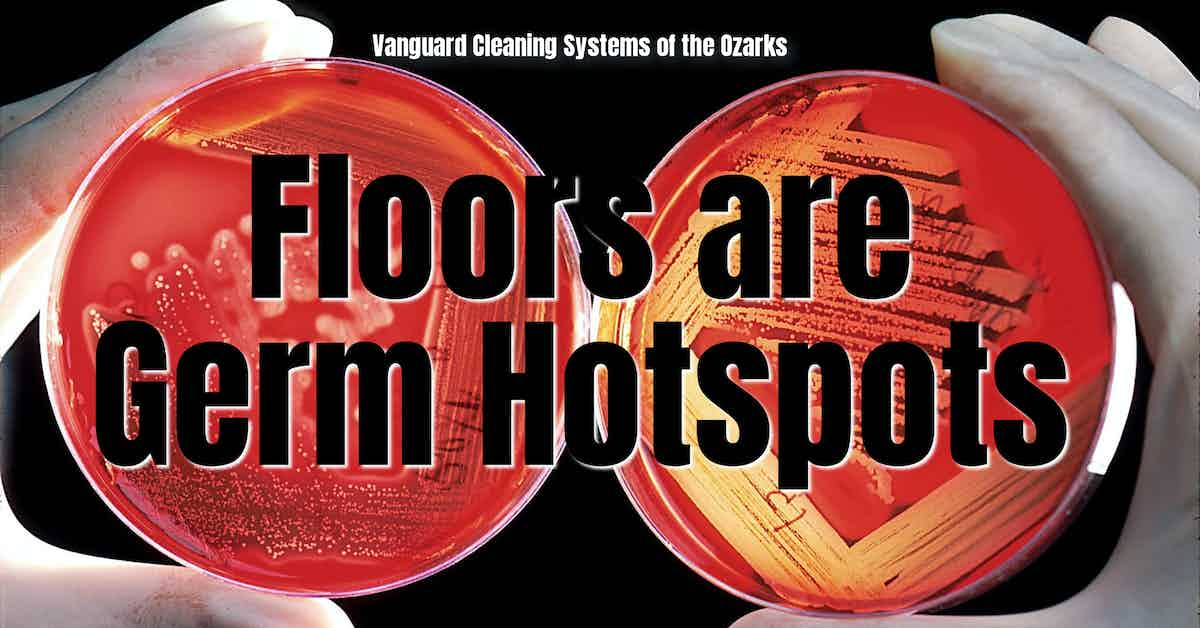Floors in public facilities represent major avenues of pathogen transmission, and high-traffic areas should be treated as germ hotspots.

Facility Floors are Major Routes of Transmission
Facility floors are commonly neglected major avenues of pathogen and pathogenic bacteria transmission.
Soil and other microbes are spread across building floors in several ways:
- They are introduced into the facility on occupant shoes and deposited on the floor.
- The floors are already contaminated--particularly restroom floors--and when people walk across them, the germs and bacteria attach to the soles of their shoes and hitchhike to other parts of the building.
- Occupants introduce pathogens and bacteria into the facility by coughing, sneezing, or through bacterial shedding that fall to the floor, and;
- Environmental toxins come into a building through open windows, doors, and inadequately filtered HVAC systems.
According to the findings of a 2017 study published in the American Journal of Infection Control, which assessed the role hospital floors played in outbreaks of superbugs;
Efforts to improve disinfection in the hospital environment usually focus on surfaces that are frequently touched by the hands of healthcare workers or patients
Although healthcare facility floors are often heavily contaminated, limited attention has been paid to disinfection of floors because they are not frequently touched.
The results of our study suggest that floors in hospital rooms could be an underappreciated source for dissemination of pathogens and are an important area for additional research.
Hospital room floors covered in bacteria from C.diff To MRSA, study finds
Further investigations found that, while facility floors may not represent a high-contact fomite in the conventional sense, high-touch objects came into contact with contaminated flooring frequently enough to invalidate any practical distinction.
Followup examinations of post-outbreak intervention strategies established that increasing floor care quality and frequency will reduce the presence and transmission of germs and bacteria.
[...] related studies have uncovered similar bacterial spreads in hospital wards dealing with the coronavirus pandemic.
The study says SARS-CoV-2, the virus causing COVID-19, frequently migrates from facility floors to the shoes of healthcare workers.
In those wards, health officials reduced this contamination by modifying standard floor cleaning and disinfection protocols in hospitals.
Hospital floors are hotspots for bacteria, allowing quick spread to surfaces and people
Enhanced Cleaning to Address Floor Care and Occupant Health Concerns
Floor care and maintenance scheduling should be based on the risk of infection transmission posed by the facility to its average occupant and how many people typically come and go in and out of the building daily.
High-risk assessments can be due to several factors, such as it being cold and flu season or the facility housing elderly patients.
The higher the risk and the more people coming in and out, the more often the floors and the facility should be cleaned and disinfected.
Most of the resources dedicated to floor care should be focused on high-traffic areas, followed by a general cleaning at the end of the day.
Deep cleaning protocols should adhere to floor manufacturer recommendations to ensure longevity and protect the floor from premature wear and tear or other damage.
Second to entryways and high-traffic sections of the building are restroom floors, which are, by a considerable margin, the germiest part of a restroom and a significant source of illness that spreads through schools, offices, and homes.
According to Gina Sloan, Ph.D., and Director of Innovations with Microban;
The floor could be harboring more germs than any other area of the bathroom.
We generally don’t clean them nearly as often as a toilet, yet floors come in contact with the same bacteria because every flush releases bacteria into the air.
Whatever is close to your toilet is going to get covered in those microbes by a little, tiny volcanic eruption every time you flush.
The Germiest Spots in Your Bathroom (Hint: Your Toilet Isn’t #1)
References & Resources
- Study Reveals High Bacteria Levels on Footwear
- Can Coronavirus Live on the Bottoms of Shoes?
- CDC study: Coronavirus could be spread over 13-feet in the air, can live on your shoes
- Your Shoes Could Make You Sick…Here’s Why
Takeaway
Facility floors and occupant shoes represent major routes or modes of infection transmission.
Maintaining facility health and hygiene requires daily floor care and maintenance and manufacturer-recommended deep cleaning procedures.
Onboarding and managing the requisite labor and material resources in the current market may prove cost-prohibitive and undesirable for many organizations.
Outsourcing is a proven method for onboarding skilled service providers equipped with the latest training, processes, and technologies for a fraction of the price of maintaining a comparable service in-house.
Contact us today and discover why Vanguard Cleaning Systems® is the Standard of Clean® for businesses throughout Northwest Arkansas, Missouri, and Oklahoma.
In Oklahoma, dial 918-960-4450
In Arkansas, dial 479-717-2410
In Missouri, dial 417-812-9777
